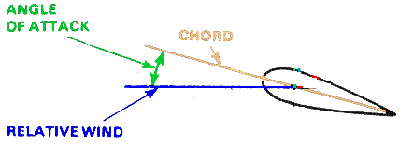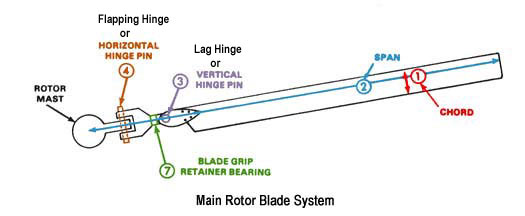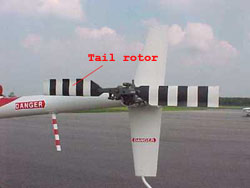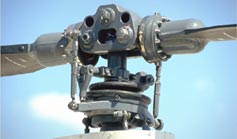GENERALThis is just the basic informations for the beginners which did not know any things about the helicopter or airplane before and wants to know some principles that why the helicopter can fly but not in deep details. For the people that want to know more than what I have in here, please go to the text book which have many professors wrote them or go to the specific helicopter manuals. The details about the helicopter has so much to put it all in the WEB. INTRODUCTIONThe wings of the airplane create a lift force when they move through the air. As we known,during flight, there are four forces acting on the helicopter or airplane and those are LIFT , DRAG , THRUST ,and WEIGHT .(please go back and see on What makes an airplane fly ? section).In order to make the wings to move through the air , of course, the plane itself has to move. A helicopter works by having its wings move through the air while the body stays still. The helicopter’s wings are called Main Rotor Blades. The shape and the angle of the blades move through the air will determine how much Lift force is created. After the helicopter lifted off the ground, the pilot can tilt the blades, causing the helicopter to tip forward or backward or sideward.NOMENCLATURE AND TECHNICAL TERMAlthough we will describe certain terms or parts of helicopter more in the next sections as we go along, but we should familier with all of these terms in order to understand the helicopter better. Bernoulli’principle :This principle states that as the air velocity increases, the pressure decreases; and as the velocity decreases, the pressure increases .Airfoil : is technically defined as any surface, such as an airplane aileron, elevator, rudder, wing, main rotor blades, or tail rotor blades designed to obtain reaction from the air through which it moves. Angle of Attack : is the acute angle measured between the chord of an airfoil and the relative wind.
Angle of Attack : is the acute angle measured between the chord of an airfoil and the relative wind. Angle of Incidence : is the acute angle between the wing’s chord line and the longitudinal axis of the airplane. (usually manufacturer had built the aircraft with the wing has some degrees to the horizontal plane or airplane longitudinal axis).Blades : The blades of the helicopter are airfoils with a very high aspect ratio ( length to chord ). The angle of incidence is adjusted by means of the control from pilots.
Angle of Incidence : is the acute angle between the wing’s chord line and the longitudinal axis of the airplane. (usually manufacturer had built the aircraft with the wing has some degrees to the horizontal plane or airplane longitudinal axis).Blades : The blades of the helicopter are airfoils with a very high aspect ratio ( length to chord ). The angle of incidence is adjusted by means of the control from pilots.
[SIZE=3]
The main rotor of the helicopter may have two, three,four , five or six blades, depending upon the design. The main rotor blades are hinged to the rotor head in such a manner that they have limited movement up and down and also they can change the pitch ( angle of incidence ). The controls for the main rotor are called Collective and Cyclic Controls.
[/size]
 The tail rotor is small blades may have two or four blades and mounted on the tail of the helicopter,it rotates in the vertical plane. The tail rotor is controlled by the rudder pedals. Its pitch can be changed as required to turn the helicopter in the direction desired.
The tail rotor is small blades may have two or four blades and mounted on the tail of the helicopter,it rotates in the vertical plane. The tail rotor is controlled by the rudder pedals. Its pitch can be changed as required to turn the helicopter in the direction desired. Blade Root : The inner end of the blades where the rotors connect to the blade gripos. Blade Grips : Large attaching points where the rotor blade connects to the hub. Rotor Hub : Sit on top of the mast , and connects the rotor blades to the control tubes. Main Rotor Mast : Rotating shaft from the transmission which connects the main rotor blades to helicopter fuselage
Blade Root : The inner end of the blades where the rotors connect to the blade gripos. Blade Grips : Large attaching points where the rotor blade connects to the hub. Rotor Hub : Sit on top of the mast , and connects the rotor blades to the control tubes. Main Rotor Mast : Rotating shaft from the transmission which connects the main rotor blades to helicopter fuselage


 Lift depends upon (1) shape of the airfoil (2) the angle of attack (3) the area of the surface exposed to the airstream (4) the square of the air speed (5) the air density.
Lift depends upon (1) shape of the airfoil (2) the angle of attack (3) the area of the surface exposed to the airstream (4) the square of the air speed (5) the air density.

 The tail rotor in normally linked to the main rotor via a system of driveshafts and gearboxes , that means if you turn the main rotor , the tail rotor is also turn.Most helicopter have a ratio of 3:1 to 6:1 . That is, if main rotor turn one rotation , the tail rotor will turn 3 revelutions (for 3:1)or 6 revolutions (for 6:1). In most helicopter the engine turns a shaft that connected to an input quill in the transmission gearbox. the main rotor mast out to the top and tail rotor drive shafts out to the tail from the tranmission gear box.
The tail rotor in normally linked to the main rotor via a system of driveshafts and gearboxes , that means if you turn the main rotor , the tail rotor is also turn.Most helicopter have a ratio of 3:1 to 6:1 . That is, if main rotor turn one rotation , the tail rotor will turn 3 revelutions (for 3:1)or 6 revolutions (for 6:1). In most helicopter the engine turns a shaft that connected to an input quill in the transmission gearbox. the main rotor mast out to the top and tail rotor drive shafts out to the tail from the tranmission gear box.






 The picture above is the typical collective lever but the detail of control may varies depend on each munufacturer .The main functions are still the same for all helicopters.
The picture above is the typical collective lever but the detail of control may varies depend on each munufacturer .The main functions are still the same for all helicopters.  In forward flight , the pedals are not used to control the heading of the helicopter (except during portions of crosswind takeoff and approach). They are used to compensate for torque to put the helicopter in longitudinal trim so that coordinated flight can be maintained.
In forward flight , the pedals are not used to control the heading of the helicopter (except during portions of crosswind takeoff and approach). They are used to compensate for torque to put the helicopter in longitudinal trim so that coordinated flight can be maintained. With the right pedal pressed or moved forward of the neutral position will cause the tail rotor blades to change the pitch angle and the nose of helicopter will yaw to the right . With the left pedal pressed or moved forward of the neutral position will cause the tail rotor blades to change the pitch angle opposite to the right pedal and the nose of helicopter will yaw to the left.
With the right pedal pressed or moved forward of the neutral position will cause the tail rotor blades to change the pitch angle and the nose of helicopter will yaw to the right . With the left pedal pressed or moved forward of the neutral position will cause the tail rotor blades to change the pitch angle opposite to the right pedal and the nose of helicopter will yaw to the left.
 The rotor disc tilts in the same direction of the cyclic stick was moved. If the cyclic stick is moved forward, the rotor disc tilt forward: if the cyclic is moved aft, the rotor disc tilt aft, and so on. The rotor disc will always tilt in the same direction that the cyclic stick is moved.
The rotor disc tilts in the same direction of the cyclic stick was moved. If the cyclic stick is moved forward, the rotor disc tilt forward: if the cyclic is moved aft, the rotor disc tilt aft, and so on. The rotor disc will always tilt in the same direction that the cyclic stick is moved.  The above picture is only typical for cyclic control stick which different manufacturer will have some detail different but the main fuction is the same.
The above picture is only typical for cyclic control stick which different manufacturer will have some detail different but the main fuction is the same.
